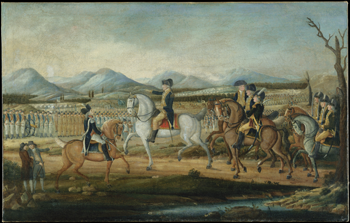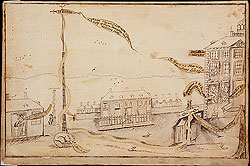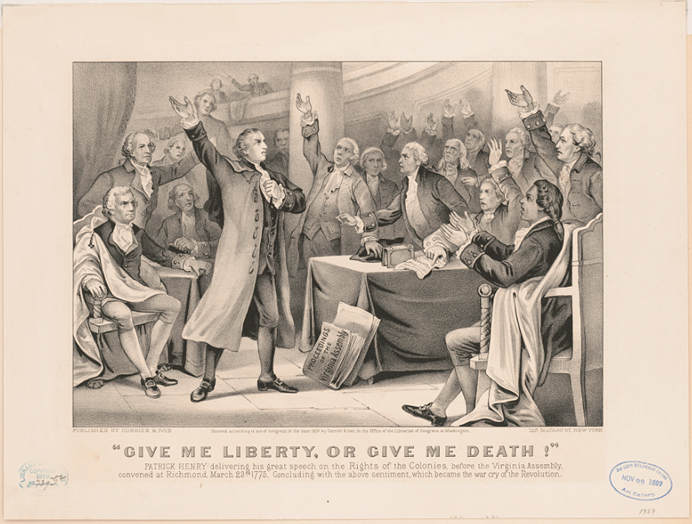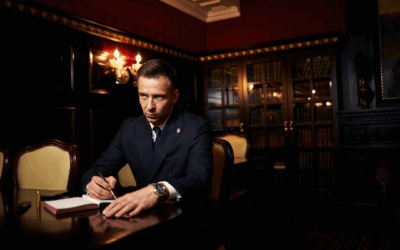The ratification of the U.S. Constitution by all states in 1790 came after the passionate debates between Federalists and Antifederalists highlighted the tensions between regional and national interests. Can a representative government succeed in balancing the local needs of communities against the needs of the nation? James Madison argued in Federalist #10 that a larger national government would protect citizens from extreme shifts in policy by factions and, as a result, protect minority groups better than the smaller state governments.[1] But this also required political minorities to submit to the realities of a representative government and respect the decisions of the majority. Citizens had to accept that a balance between benefits and disappointments was part of establishing a peaceful government. In theory many agreed this was a fair exchange but in practice there were still lingering tensions. For many it was difficult to suddenly accept that national interests superseded their local needs. Conflicts could turn violent when local political majorities found themselves political minorities at the national level. This struggle set off the Pennsylvania Regulations of the 1790s, known more commonly as the Whiskey Rebellion and Fries’s Rebellion. These Regulators struggled to connect with those beyond their communities. They cast themselves as virtuous citizens doing their part to correct corrupt laws and officials but nationally they were seen as rebels and anarchists. In part, it was their use of arms that made these Regulators unpopular as public opinion shifted and disparaged violent protest while favoring peaceful petitions, elections, and legal reforms. The time for localized armed regulation movements by citizens, even when organized through the local militia, was drawing to an end.
The two previous articles in this series examined how Regulation movements had two competing definitions.[2] The Regulators, later identifying themselves with the “body of the people,” believed they had the right and duty to check missteps and corruption by their government. This included a range of actions from organizing petitions to closing court proceedings to armed resistance. Conversely, government officials viewed regulation movements warily since they skirted the edge of legality. While officials might encourage petitions and even forgive initial mob violence, they drew the line at armed insurrection and the disruption or bullying of the courts. Regulators were recast as rebels and anarchists who were trying to overthrow the government.
The Massachusetts Regulation or Shays’s Rebellion illustrated the shift from local governments begrudgingly listening to some of the Regulators’ demands to denying these movements had any legitimacy after the American Revolution. The rebellion was used to argue for a stronger national government that could protect state governments from internal insurrections. But the Pennsylvania regulation movements of the 1790s revealed that the popular definition of the “body of the people” continued to differ from the legal definition envisioned by the Founders.[3]
The Founders strongly believed the “body of the people” was central to the success of the new country, however, many also thought that representative government provided the legal means for expressing grievances. Therefore, the voice and interests of the “body of the people” was expressed through the electoral process. Elected representatives passed laws on behalf of the people and the courts reviewed laws as needed to avoid “dangerous innovations” and protected the masses from “occasional ill humors in the society.”[4] Citizens should trust that judicial review would correct any missteps. There was no excuse for Regulators to shut down courts and disrupt the very process that offered them legal recourse. During Shays’s Rebellion it became clear that firebrands of the American Revolution, such as Samuel Adams, strongly believed that armed resistance served a purpose when a government did not represent the people but had no legitimacy under a functioning representative government. But many Regulators felt their voices were unheard by legislators and their grievances remained unanswered by the courts. Was this representative government really working for them? Did they really have any influence or control in their government? And now there was this new national government. Where the Antifederalists right? Was this national government too distant and disconnected from the people to address local concerns, especially when that group felt they were a political majority in their community? These questions made national headlines in 1794 and 1799. The Pennsylvania Regulations, or the Whiskey Rebellion and Fries’s Rebellion, provided the framework wherein local disruptions were used to debate federal power and answer questions about the balance between local and national interests. After the rebellions were suppressed, a general consensus arose, even among those sympathetic to their cause, that regulation movements were unlawful. Instead, the “body of the people” expressed their will through the electoral process and any checks on government would be organized through those elected officials.
The Whiskey Rebellion
Image 1: George Washington and the Whiskey Rebellion Click image for a larger view.

“Washington Reviewing the Western Army, at Fort Cumberland, Maryland.” c.1795. Attributed to Frederick Kemmelmeyer. The Metropolitan Museum of Art.
In January 1791 the Excise Whiskey Tax passed in Congress as a partial means to pay off the national debt. Many felt this put an undue burden on western and southern frontier farmers who did not have ready access to markets for their grain. Additionally, petitioners claimed they did not have the money to pay the whiskey tax since many of them used it to barter for goods rather than receive a cash payment. Within the first year there were attacks on tax collectors in western Pennsylvania and attacks on those who complied began the following year.[5] “Tom the Tinker” would “mend” the stills of those paying the tax with bullet holes.[6] For several years officials seemed too frightened to enforce the tax until July 1794.[7] The tax collector John Neville, aided by the federal marshal, tried to serve warrants for tax evaders with summons to appear at the federal court. A crowd surrounded Neville’s home looking for the marshal and Neville shot into the crowd, killing one. Neville requested reinforcements from Fort Pitt who faced off against a growing number of farmers and militiamen; after another shoot-out Neville’s estate was burned.[8] Local leaders and militiamen met on Braddock’s Field outside Pittsburgh and demonstrated their numbers with a peaceful march of 7,000 through the city.[9] Alexander Hamilton, who had introduced the Whiskey Tax, published an open letter appealing for federal action arguing the tax evaders had, “matured to a point, that threatens the foundations of the government & of the Union; unless speedily & effectually subdued.”[10] For the first time under the new U.S. Constitution the federal government moved to suppress an insurrection. President George Washington met with representatives from Pennsylvania who felt they could handle the rebellion through their courts. But Washington was still concerned that the state would be too weak to adequately eliminate unrest.[11] The federal government mustered militia from Virginia, New Jersey, Maryland and eastern Pennsylvania.[12] The Regulators in western Pennsylvania voted not to fight and quickly dissolved. Regardless, encouraged by the insistence of Hamilton, the militia force marched westward under the command of Virginia Governor Henry Lee and arrested those involved in the rebellion. In the end the rebels were met with leniency by the courts. The only two convicted of treason were pardoned by Washington; because he thought one was a simpleton, and the other insane.[13] But an estimated 2,000 Regulators left the state, some as far as the Spanish Territory across the Mississippi, to further remove themselves from what they viewed as an overbearing federal government.[14]
The Grievances
So was the whiskey rebellion really about a whiskey tax? Excise taxes on whiskey or similar “luxury” taxes were not necessarily new; the British had tried the same thing in 1733.[15] But this tax seemed excessive at 25% of the market value and more burdensome to poor farmers who could not get the legal tender to pay the tax. If charged, rural violators had to appear in federal court which was an added burden due to distance, time, and expense. The legislature did lower the tax and allow state courts to hear some cases, but this did not quell the discontent.[16] There were also accusations of unfair enforcement and preferential treatment towards Federalist distillers.[17] But closer review shows that the whiskey tax was not the sole cause of the rebellion. The whiskey tax created a flashpoint that highlighted deeper concerns with corruption in government and a lack of political representation very similar to earlier regulation movements.
The Regulators from Pennsylvania had several grievances that hinged on protecting their homes and livelihoods rather than one sin tax. Several economic and political concerns troubled the Regulators such as the favoritism for land speculators over farmers and veterans, increasing debts, the lack of hard currency to pay taxes, and recent changes in the state constitution that influenced the local courts. The farmers that settled western Pennsylvania often competed with land speculators who surveyed and purchased titles to the land on which the farmers where building. Although some of the farmers’ land claims were not legal, many of these farmers believed land should belong to those willing to improve it and added that land offices were often too far away to legalize their claims properly and quickly. They asked for laws that would limit the amount of land that speculators could own and higher tax rates for unused land. But votes for reformist candidates failed to change policies as these politicians changed sides or ignored these concerns once in office. The speculators instead received tax exemptions for their lands and the state Supreme Court struck down attempts to set up settlement requirements or purchase limits.[18] At the same time land speculators received these tax breaks everyday farmers faced increased debts. The same depression that hit Massachusetts and influenced Shays’s Rebellion was experienced in other areas of the country as well. And just like in Massachusetts, after the war many farmers, artisans, and veterans sold their certificates at a fraction of their worth to speculators in attempts to settle their mounting debts and obtain the hard currency required to pay state taxes. But this was often not enough. For many struggling farmers their debt then increased when lenders took them to debtor’s court and the only way to forestall foreclosure was by incurring additional court and lawyer fees.[19] Courts were viewed as unsympathetic and in 1790 the revised state constitution placed the appointment of justices with the state legislature which replaced previous local appointments. This increased the perception that communities lacked representation and local militias set up their own alternative debtor’s courts in protest.[20] Then, that same year, the new federal government passed the Funding Act that agreed to pay speculators the full value (or more due to interest) on certificates purchased after the war.[21] Once again it was the speculators who had the ear and support of government.
Again, as seen in other regulator movements, the Whiskey Rebellion did not happen overnight but was the climatic event in a series of actions by western Pennsylvanian settlers. Early on, petitions voiced concerns and liberty poles were raised to express dissent. Debtors were protected by community action. Crowds sometimes violently closed down auctions of a debtor’s property or made unofficial no-bid contracts with their neighbors. The auction of a debtor’s property due to foreclosure often took place at the farm or in the nearby town. Because of this, no-bid crowds could be very influential and prevent the auctioneer from making any profit from the debtor’s goods – effectively shutting it down. Additionally, farmers blocked and closed roads to prevent foreclosures on specific properties. If the sheriff and auctioneer could not reach the house with the wagon, they could not take anything away.[22] As already noted above, local militias held their own debtor’s courts after local justices were replaced with those appointed by the state. Even if the militia did not take direct action they often aided popular protest by practicing “militia nullification” or refusing to muster and suppress crowd action. This became enough of a problem that Governor Thomas Mifflin had to enact fines and punishments for militiamen who failed to perform their duty.[23] But this did not stop militiamen from participating in local meetings and coordinating protest and petitions within their communities.
Debating Legitimacy
Many that were drawn into the regulation movement, militia and otherwise, argued it was not only their right but their “political obligation” to take a stand against mounting injustice.[24] To defend their actions they could invoke the 1776 Pennsylvania Constitution that stated:
That government is, or ought to be, instituted for the common benefit, protection and security of the people, nation or community; and not for the particular emolument or advantage of any single man, family, or sett of men, who are a part only of that community; And that the community hath an indubitable, unalienable and, indefeasible right to reform, alter, or abolish government in such manner as shall be by that community judged most conducive to the public weal.[25]
“It seems to be an idea entertained by the people that we can remain a part of government and yet wage war against it. That is impossible in the nature of the case; we are known to the government by representation only and not by force. We must therefore either overthrow it or it must overthrow us. But we have sworn to support it. If we contemplate overthrowing it, where is our oath of allegiance? But can we overthrow it? We might as well think of tossing the Allegheny mountain from its base….But cannot we cecede from the union? Not, and remain part of the government at the same time. We must dissolve our connection with PA before we can cease to be under the government of the United States. But have we a right to dissolve our union with both? An individual may emigrate from society and a part of the society may emigrate from the whole, but an individual cannot leave a state in war because he owes service for the benefits he has enjoyed in peace. He cannot leave it without discharging debts he owes to individuals or to the public. How then can a part of the community separate before it has discharged the obligations contracted by the whole?”
Hugh Henry Brackenridge, Incidents of the Insurrection in the Western Parts of Pennsylvania, 1795 [26]
But the choice by Regulators to take up arms to effect political change were quickly associated with populist uprisings that threatened civil war and anarchy. This rhetoric of anarchy was further fueled by contemporary events. The French Revolution became the Reign of Terror in 1793 and the execution of the king and the aristocracy quickly turned to a hunt for any political enemies of the new republic. This turn of events and the French encouragement of revolutions outside of France led many Federalists to publish scathing accounts of popular unrest.[27] They tied populist ideas and behavior to Democratic-Societies run by Democratic-Republicans who they labeled as a dangerous faction and “our anarchy-men.”[28] These societies had celebrated the French Revolution and embraced the idea of more active and better educated citizens. To achieve this goal they developed Democratic-Societies where members could gain more “perfect knowledge” of politics essential to a republic. But the Federalists criticized them for limiting membership to like-minded Democratic-Republicans and holding private meetings at night. The Federalists considered Democratic-Society meetings subversive and accused them of encouraging minority insurgents and revolutionaries to follow the French “mob” example.[29] Washington directly linked the Whiskey Rebellion to the Democratic-Societies in his address to Congress in November of 1794.[30] The report that protesters in Pennsylvania had raised a tri-colored flag above the courthouse at Harrisburg only helped to strengthen ties between the French “mob” and the Regulators.[31] But beyond a connection with the devolving French Revolution, Federalists again highlighted that typical regulation action, like closing the courts, was not the correct behavior of a republican citizen. In Alexander Hamilton’s open letter for action against the regulators he stated that:
The idea of pursuing legal measures to obstruct the operation of a Law needs little comment. Legal measures may be pursued to procure the repeal of a law, but to obstruct its operation presents a contradiction in terms. The operation, or what is the same thing, the execution of the law, cannot be obstructed, after it has been constitutionally enacted, without illegality and crime. The expression quoted is one of those phrases which can only be used to conceal a disorderly & culpable intention under forms that may escape the hold of the law.[32]
Despite the strong rhetoric against the Regulators, there were still some sympathetic to their plight. Before the state militias were mustered by Washington several liberty poles were raised by militia companies in Virginia and Maryland.[33] But many were cautious. Judge Alexander Addison agreed that the tax was unjust but denounced the use of arms by the Regulators. After the rebellion was over he blamed the rebellion on a few landless trouble makers and appealed for clemency for most of the farmers involved.[34] Influential Democratic-Republicans like Thomas Jefferson and James Madison disliked the tax and were upset that the Democratic-Societies were tied with the rebellion. But they kept their objections private and their letters also show their concern that armed protest like the Whiskey Rebellion would only strengthen the Federal government.[35] Instead of praising the rebels for watering the tree of liberty with blood as he had after Shays’s Rebellion, Jefferson was more cautious and concerned that the conflict also undermined the government as a whole.[36] Within the decade Jefferson and Madison would propose a state directed form of organizing the “body of the people” in preference over the smaller populist rebellions that achieved little and lacked the broad appeal necessary to create real change nationally.
The example of the first Pennsylvania Regulation or Whiskey Rebellion illustrates how public opinion was shifting from regulation movements. Many agreed that the tax was unjust but denounced any action that involved armed protest or the use of the militia. The “body of the people” was still praised but events like this one were seen as too localized and regional. These rebels did not represent the national “body of the people.” The Federalists’ propaganda against the rebels and their supposed connection to Democratic-Societies helped accentuate the rebellion as isolated, radical, and subversive. Even Democratic-Republicans were split as moderates favored measured debate, petition, and political action while radicals called for armed regulation movements that invoked the “body of the people” organized through the militias. Within a few years, the second Pennsylvania Regulation, or Fries’s Rebellion, revealed how armed protest was even more quickly isolated and delegitimized.
Fries’s Rebellion
At the end of the 18th century, the nascent United States tried to maintain neutrality with Britain and France but the Jay Treaty of 1795 was viewed by many to favor Britain. Despite claims of neutrality, the United States was pulled into the unofficial Quasi-War with France under President John Adams. This uncertain time justified the first peacetime standing army under the new constitution.[37] Unpopular among many, it became even more so after funding this army required new direct taxes on land, houses, and slaves as well as a stamp tax on legal documents.[38] As tensions increased the infamous Alien and Sedition Acts were passed in 1798 to stop potentially subversive groups and prevent insubordinate critiques of the government. Within this atmosphere tax protests and evasion were not uncommon. But a flashpoint was reached in March 1799 in the German-speaking counties north of Philadelphia.
The Second Pennsylvania Regulation or Fries’s Rebellion was the shortest of these regulation movements. At the start of March, the Federal Marshal William Nichols began serving warrants and holding tax evaders at an inn in Bethlehem, Northampton County with plans to take them to Philadelphia for trial. An angry crowd gathered and nearby local militias mustered. By March 7th the marshal faced a force of up to 400 armed men led by the militia captain John Fries. Fries negotiated with Nichols for several hours. The community wanted to see the men tried locally and offered to pay their bail. At first Nichols refused but, aware that tensions were rising and the situation deteriorating, he eventually agreed. But Nichols maintained that he was forced to leave and refused to take the bail money since the militia’s actions were illegal and obstructed the course of law.[39] The militia quickly dispersed but the Philadelphia press warned of the “Northampton Insurrection.”[40] The press linked the ongoing fear that the French were trying to undermine the American government with the rebellion. They referenced their membership in Democratic-Societies and wearing of tri-colored badges which linked them with French revolutionaries.[41] Congress had just granted the President the power to use both the army and militia to suppress insurrections under the Eventual Army Act. A combined regular and militia force of about 3000 was mustered over next four weeks. By early April they marched north to make arrests even though there had not been any continued violence and some had already turned themselves over to authorities or expressed their willingness to stand trial.[42] The trial of John Fries took center stage in the press as the Federalists denounced popular revolts and tied them to anarchy.[43] For the Federalists this was a continuation of unrest in Pennsylvania that had not been settled with the suppression of the Whiskey Rebellion. An example needed to be made to stop radicals from undermining the government once and for all. In a letter to Adams, Timothy Pickering warned:
This conviction is of the highest importance to vindicate the violated laws and support the Government…an example of examples of conviction and punishment of such high handed offenders are essential to ensure future obedience to the laws…and to suppress future insurrections. The examples appear singularly important in Pennsylvania, where treason and rebellion have so repeatedly reared their heads. And painful as is the idea of taking the life of a man, I feel a calm and solid satisfaction that an opportunity is now presented in executing the just sentence of the law, to crush that spirit, which if not overthrown and destroyed, may proceed in its career and overthrow the Government.[44]
But, despite pressure from his own party, President Adams pardoned Fries following the example of Washington during the Whiskey Rebellion. But did Fries and the other German militia represent a seditious alien conspiracy within the United States as charged by the Federalists? On closer review these German-Americans had more in common with previous regulation movements.
The Grievances
As seen in other regulation movements, there were several causes for unrest and protest by German-Americans in Pennsylvania. Like many other Americans they were upset with the new taxes for the Quasi-War with France. In particular this taxation seemed to favor land speculators over farmers once again. The direct tax on property charged a higher rate of tax on improved lands. The farmer who had invested in improving his property was forced to pay more than a land speculator who did nothing with his land.[45] The constitutionality of the tax was questioned since it was unequal and required assessors to enter homes to assess property.[46] Many German-Americans thought it was too similar to the “hearth taxes” back in Europe which they identified with the very type of corruption and unfairness the American Revolution had meant to correct.[47] Additionally, the Alien and Sedition Acts and the new Stamp Act were interpreted as a return to British-style tyranny.[48] Liberty poles raised in 1799 referenced both British tyranny and the recent Whiskey Rebellion, for example:
Tone the Tinkerer, author.Liberty & No Excise & No Stamp Act.Mr. Wells you are cheating son of a Bitch.Huzza for Liberty & No Excise & No Stamp Act.This Liberty Pole is erected by Tone the Tinkerer andwhoever cuts it down or demolishes it shall have his house torn down and demolished.[49]
And once again these taxes and policies were hitting while many were struggling with increased debt and the added burden of paying their taxes with hard currency.[50] Finally, as seen already, the new state constitution of 1790 changed the appointment of judges and removed them from local control. German-Americans in eastern Pennsylvania petitioned to get judges that a spoke German, especially for the rising number of debt cases.[51] In these respects the issues that concerned these Regulators had a lot in common with earlier regulations.
Debating Legitimacy
The actions taken by these German-Americans again followed popular ideas of protest. Many refused to pay taxes outright and obstructed attempts to assess property for tax purposes. There was some sympathy for tax collectors; for example, the Albany Township promised to pay the assessor for any fines he incurred for not collecting their taxes, but they refused to pay the tax itself.[52] But most tax collectors met threats and angry crowds. Popular accounts of the “Hot Water War” spread as women supposedly dumped hot water on assessors as they measured house windows.[53] To help debtors, local no-bid contracts and road closures were again used to stop foreclosures of property.[54] These German-Americans were highly literate and were politically involved in associations that debated courses of action and drew up petitions.[55] Many in the region felt expressing political ideas were part of their right and duty as citizens. Several had fought in the Revolution or were closely connected.[56] Many came to meetings dressed in their militia uniforms to highlight this association with their civic duty as the “body of the people.”[57] As mentioned above, liberty poles were raised expressing these political ideals:
Image 2: Liberty Pole

“Raising the Liberty Pole in New York City,” pen and ink drawing by Pierre Eugene du Simitiere, New York, 1770. Wikipedia.org.
The Constitution Sacred,No Gagg Laws, Liberty or Death[58]The United States of AmericaFree, Sovereign, and Independent[59]
Despite these similarities some of those involved in the regulation did not see ties between their own cause and the earlier Pennsylvania Regulation; in fact some of them had marched as militia against the Whiskey rebels.[60] And although many did support Jefferson and the Democratic-Republicans, some, like Fries himself, were staunch Federalists who sincerely felt they were checking an errant turn of events rather than trying to overthrow the Federalist government.[61]
The Democratic-Republicans, viewed as sympathetic to regulation movements by the “body of the people,” now condemned the rebellion and similar violent protest. Once again Thomas Jefferson warned that violence was only strengthening the government as people looked for order and stability:
In this State, we fear that the ill designing may produce insurrection. Nothing could be so fatal. Anything like force would check the progress of the public opinion & rally them round the government. This is not the kind of opposition the American people will permit. But keep away all show of force, and they will bear down the evil propensities of the government, by the constitutional means of election & petition.[62]
During the summer of 1799 after Fries’s Rebellion, Democratic-Republicans stressed their approval of law and branded themselves as “Friends of Order.”[63] In part it was feared that Fries’s Rebellion would hurt the promotion of the Kentucky and Virginia Resolutions proposed in 1798.[64] These resolutions, mostly focused on the Alien and Sedition Acts, proposed that states had the right to nullify federal legislation and the duty to do so as representatives of the people.[65] The move shifted the organization of regulation from below by local leaders and militias to an organization on behalf of the people from above by elected leaders and their use of the militia. Caught in the greater political debates of the day, the second Pennsylvania Regulation or Fries’s Rebellion was used by both parties to effectively denounce the use of arms by local populist movements to regulate government. Always on tenuous ground for legitimacy, these movements were delegitimized as too factious and ineffectual for the new nation.
Conclusion
“For with them the power of individuals is their liberty whereas, in truth, there can be no liberty unless the power of individuals is restrained by law.”
New England Palladium 22 May 1801 [66]
The Pennsylvania Regulations of the 1790s, or the Whiskey Rebellion and Fries’s Rebellion, provide case studies in the continued shift from tenuous popular support for unpredictable regulation movements to acceptance and promotion of limited protest by petition, election, and reforming laws. Even Jefferson, who had quipped that blood fed the tree of liberty, felt that government was a more effectual vehicle of change. Violent protest by citizens without guidance achieved nothing but to make a stronger government in the end.
This did not, however, create a definitive end to violent political protest. There is less reference to regulators and regulation, but “Liberty-Men” and other protectors of liberty appeared throughout the 19th century.[67] The same popular rhetoric from the Revolution and regulation movements that was used to justify violence appeared in protests by abolitionists in the 1840s and 1850s and appeared in politically motivated riots as well.[68] In a case from the Dorr Rebellion of 1842 the US Supreme Court in Luther v. Borden, 48 U.S. 1 (1849) again reasserted the preference for peaceful action when, “the popular will can be felt and triumph through the popular vote and the delegates of the people in the legislature, and will thus lead soon, and peacefully, to legislative measures ending in reform, pursuant to legislative countenance and without the necessity of any stronger collateral course.” If a group did use violence to oppose government, they knew that, “unless crowned by success, and thus subsequently ratified, they will often be punished as rebellious or treasonable.” Violence within and against the existing government was seen as extralegal and treasonous unless the revolution was successful. The Court reiterated that a lawful government has every right to protect itself:
And, unquestionably, a State may use its military power to put down an armed insurrection, too strong to be controlled by the civil authority. The power is essential to the existence of every government, essential to the preservation of order and free institutions, and is as necessary to the States of this Union as to any other government. The State itself must determine what degree of force the crisis demands.[69]
After the Civil War both popular regulation and state nullification fell into further disfavor.[70] Violent protest did not disappear but lost its association with any tradition of armed regulation by the people to correct government. Over time many factors from the development of police departments to changes in the militia to new protest models would further remove citizens from notions of armed regulation. The 18th century regulation movements like the North Carolina Regulation or the Pennsylvania Regulations just simply do not fit within the scope of the changes in American society. The idea that citizens and local militias should take up arms to effect political change was delegitimized by the Founders and remains so for the majority of the “body of the people” today.
Cover Image provided by Currier & Ives Library of Congress http://www.loc.gov/ Publish date 01/01/1876





0 Comments